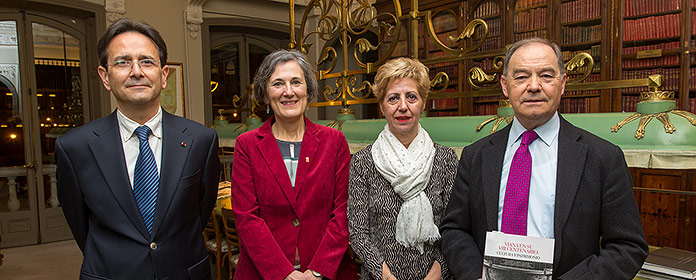The Chair de Patrimonio y Arte Navarro presents the book "Viana en su VIII centenario: cultura y patrimonio" (Viana in its VIII centenary: culture and heritage).
The event was attended by Ricardo Fernández Gracia, director of the Chair; Yolanda González, Mayoress of Viana; Román Felones, coordinator of the publication; and Ana Burusco, Director General of the University of the Government of Navarra.

On Thursday, January 30, at the Nuevo Casino of Pamplona, took place the presentation of the book "Viana en su VIII centenario: cultura y patrimonio" (Viana in its VIII centenary: culture and heritage). Published by the City Council of Viana, the work collects the lectures of the course organized, in September 2019, by the Chair of Heritage and Navarrese Art of the School of Philosophy and Letters of the University of Navarra, and sponsored by the Government of Navarra.
The event was presided over by Ricardo Fernández Gracia, director of the Chair de Patrimonio y Arte Navarro; Yolanda González, mayoress of Viana; Román Felones, coordinator of the publication; and Ana Burusco, general director of the University, representing Juan Cruz Cigudosa, counselor of the department of University, Innovation and Digital Transformation of the Government of Navarra.
In his speech, Ricardo Fernández Gracia said that in this book, "readers will find the basics of how many cultural assets Viana treasures. There are fundamental pieces to understand what it has been, because it has a set of monumental and movable art essential in the history of Navarre, peninsular and European art". In this sense, he recalled the recommendations of Unesco in order to disseminate and enhance the value of research on cultural heritage.
For her part, the mayoress of Viana, Yolanda González, acknowledged the satisfaction of the people of Viana with the result of work: "This book is a call to visit Viana and to know ourselves. The Chair de Patrimonio y Arte Navarro has given us to know our art, which we do not always know how to appreciate, to take care of it, to spread it and to value it". "Knowing our past we will be able to put the instructions of our future and that of the generations to come," he added.
Román Felones, coordinator of the work, stated that it is intended as a tribute to Juan Cruz Labeaga, the main historian of Viana: "It is made for the people of Viana, but it should be dedicated to Juan Cruz, as a tribute of affection and recognition". He also pointed out that "we have tried to make these texts informative, but of high quality".
On the other hand, he explained to the attendees the structure and content of the work. As he pointed out, the first chapter, signed by him, revolves around the "History of the stories of Viana", and reviews what has been written about the city. The second chapter, written by Carlos Martínez Álava, is dedicated to the churches of San Pedro and Santa María. In relation to the latter, Román Felones questioned the religious and civil authorities "because its status is delicate and needs urgent intervention". The third part of the work is signed by Pilar Andueza and dedicated to the architectural framework of the city and its domestic architecture. For his part, José Javier Azanza analyzes in chapter four the chapel of San Juan del Ramo and the paintings of Paret. The fifth chapter, by María Josefa Tarifa, is dedicated to the façade of Santa María. Next, Ignacio Miguéliz discusses "The sumptuary arts" preserved in Viana. In reference to this sixth chapter, section, Román Felones explained that "a city like Viana had to accumulate important elements of liturgical trousseau and, although many have disappeared, fortunately we can count on three singular pieces that Ignacio Miguéliz has studied in detail". In the seventh chapter, Félix Cariñanos talks about the historical and cultural singularities of the city. The work ends with a selection of five images of Viana chosen by Francisco Javier Villanueva, architect and author of the phorography that illustrates the book's cover.
Before the end of the event, Ana Burusco, Director General of the University of the Government of Navarra, spoke, expressing the "commitment of department with this subject of initiatives to bring heritage closer to the citizens, as it is a fundamental part of our history and our land".
